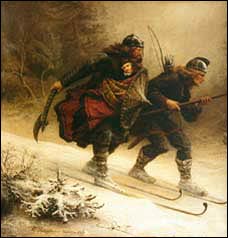The build-up and pure hype went on for months, and this weekend’s annual Birkebeiner ski marathon set a new record even before its start. Some 16,000 men and women stormed over a mountain range in eastern Norway, to prove their strength and skills not least to themselves.

This year marked the 73rd Birkebeinerrennet, which starts in the small town of Rena and ends 54 kilometers later at a stadium in Lillehammer. The fastest racers make the run over the mountains in less than three hours. (And the winner was…)
Registration for this year’s race sold out record early, according to organizers. It was fully booked by mid-December, with the largest category made up of men in their 40s. Norwegian newspapers have been packed with articles about the race since, covering everything from training methods to equipment to psychological analysis of why the race is so attractive and popular, especially with middle-aged men.
‘Running away’
“This is all about running away from the aging process, from weakness and deterioration,” Professor Per Fugelli told newspaper Dagens Næringsliv (DN). He and psychologist Arnul Kolstad have followed the record participation in the Birkebeiner race with some worry, because it can become an obsession, a physical ordeal that’s not necessarily healthy and simply a means of showing off.
“It’s typically Norwegian to use sports to show others that you’re capable of exhausting yourself entirely,” said Kolstad. “The Chinese would never dream of using sweat and muscle to prove themselves.”

The huge participation in recent years is linked to the numbers of baby-boomers now in their 40s and 50s and eager to prove that they’re still fit and competitive. The race has become wildly popular within Norway’s business world, with companies mounting teams, sponsoring employees and organizing training programs, under the belief that it promotes health and teamwork.
Exposure vs. real leadership
Some experts in organizational psychology are issuing warnings, though, saying that taking part in the Birkebeiner race is no metaphor for good leadership.
“Participation is more about a leader’s need for exposure than it is about showing clear leadership,” psychologist Jan Christophersen told newspaper Aftenposten on Friday. Participants, he notes, have to invest lots of time on their bodies, technique and equipment, which in turn portrays them as “lonesome, strong and endurance-minded.” He thinks employees may be wishing the leaders instead “had used more time on us, than on spending hours running around on the ski trails every week.”
Families can also suffer during the most eager race participants’ preparation. In order to ski 54 kilometers up and down a mountain range, they must be in good shape, which means a training regime all winter long that can come at the expense of time with family and friends.

‘Purely positive’
Birkebeiner participants tend to shrug off the concerns, with Liv Kindem, for example, saying she views the race as “purely positive.” She’s the marketing director for Choice Hotels in Norway, and told Aftenposten she has “an incredibly good relationship” with her fellow colleagues who also planned to “go Birkebeiner” over the weekend.
Much of the newspaper hype may simply be linked to good business for the papers themselves. Many of DN’s readers, for example, are precisely the middle-aged men most likely to run the race, and DN’s barrage of articles about heavy physical training in recent months has attracted a wide range of advertisers for everything from sportswear to ski equipment. DN even ran a “Birken-extra” edition last week, that ran over 14 pages.
The race isn’t exclusively for middle-aged men, of course. Anyone who’s at least 16 years old by December 31 can take part, there’s a wide range of age categories and all must carry a backpack weighing at least 3.5 kilos that contains a wind breaker, dry underwear, drinks, food and ski wax. Everyone who completes the race gets a pin while those performing well are eligible for a wide range of awards.
The race was first organized in 1932, to commemorate a historical ski trip in the 1200s by soldiers loyal to the king who wore birch bark to protect their legs. They carried the heir to the throne at the time, leading to the backpack requirement meant to symbolize the infant heir’s weight.
Views and News from Norway/Nina Berglund
Join our Forum if you’d like to comment on this story.

